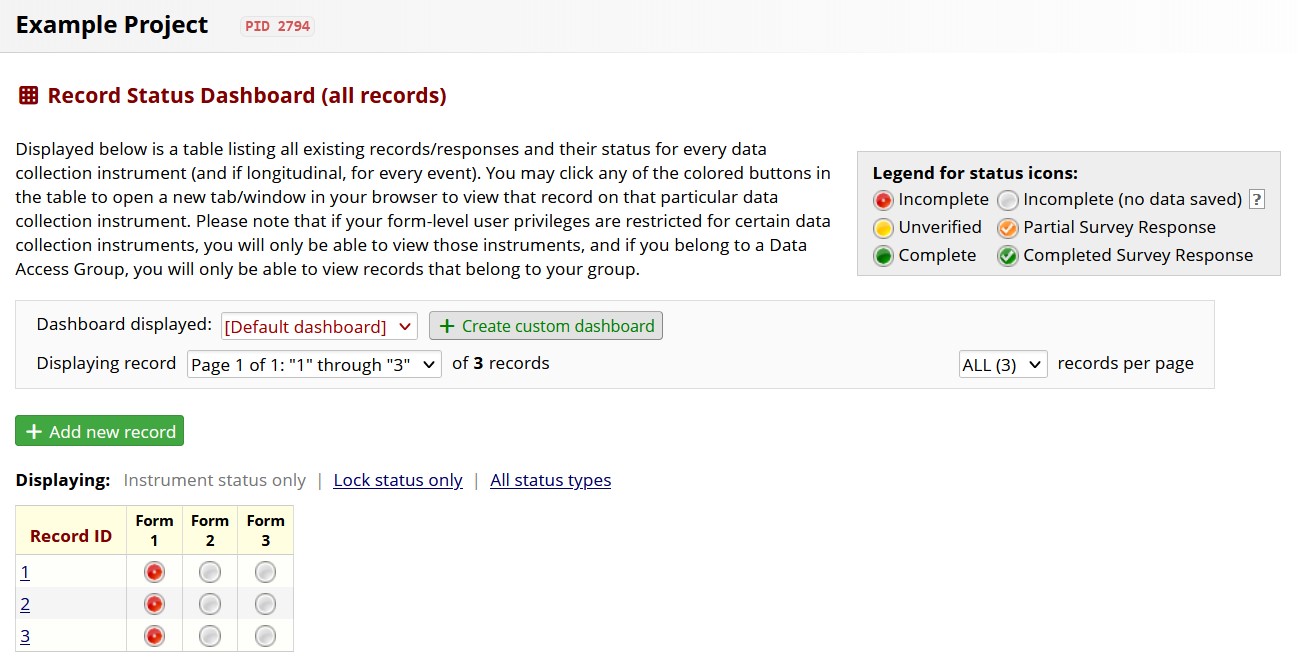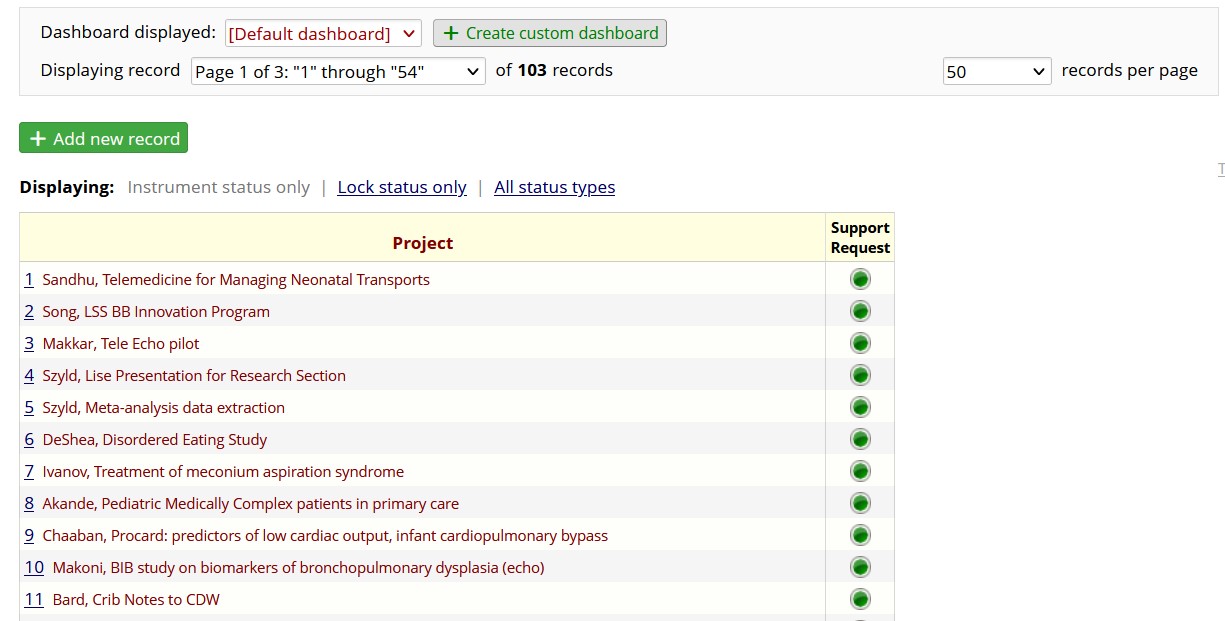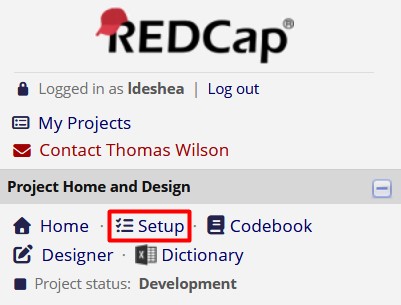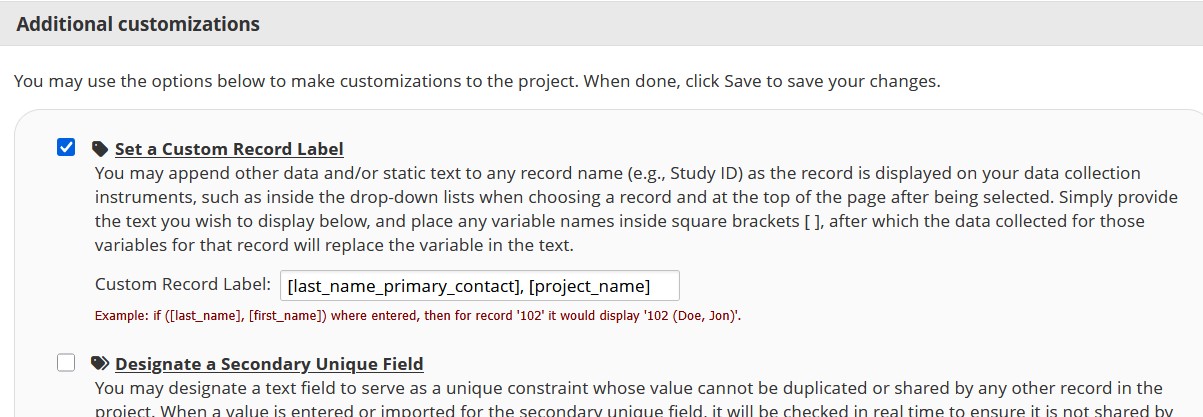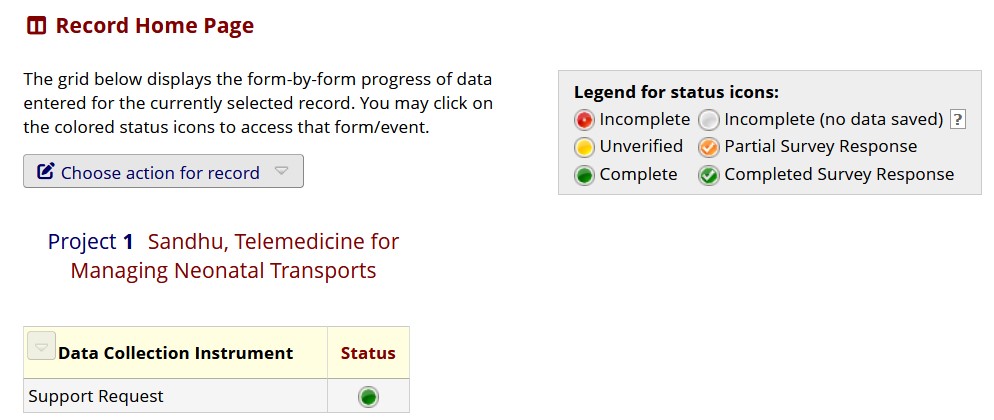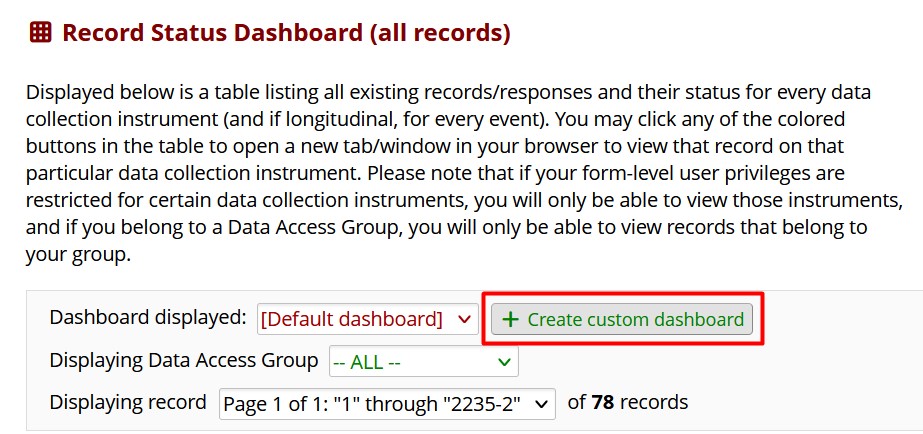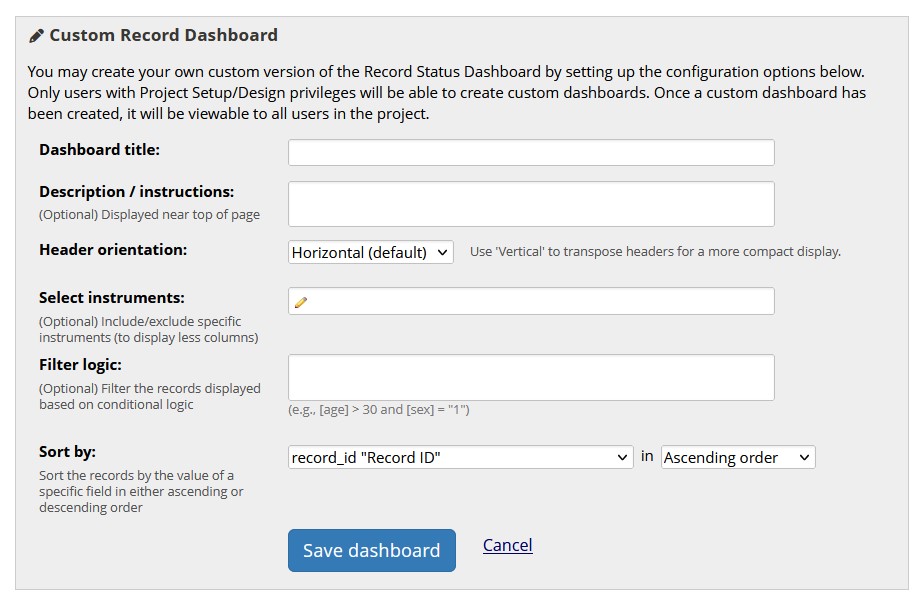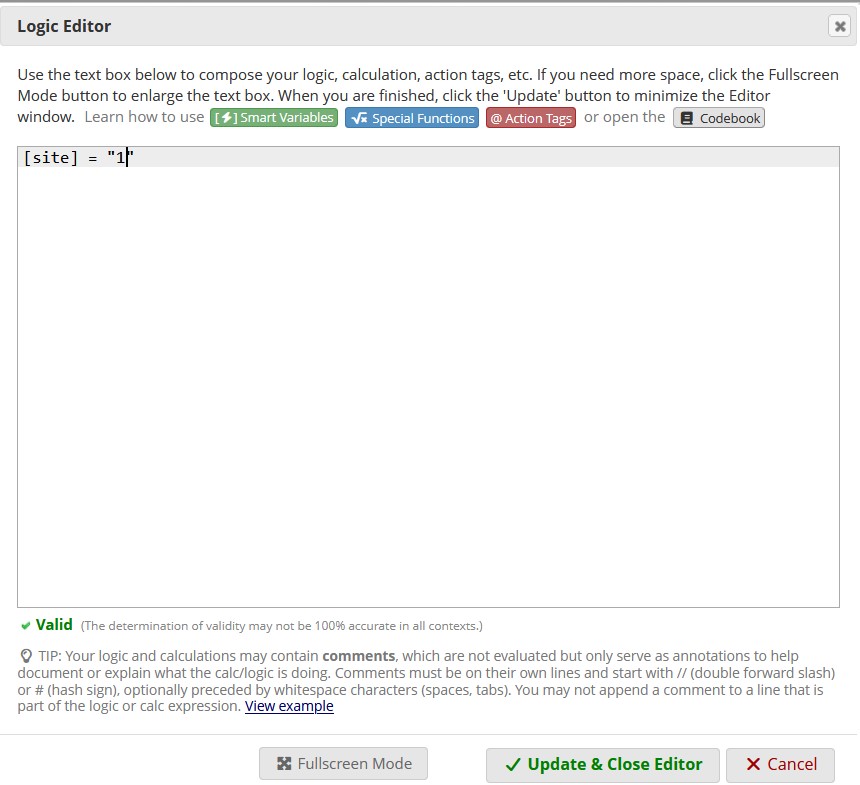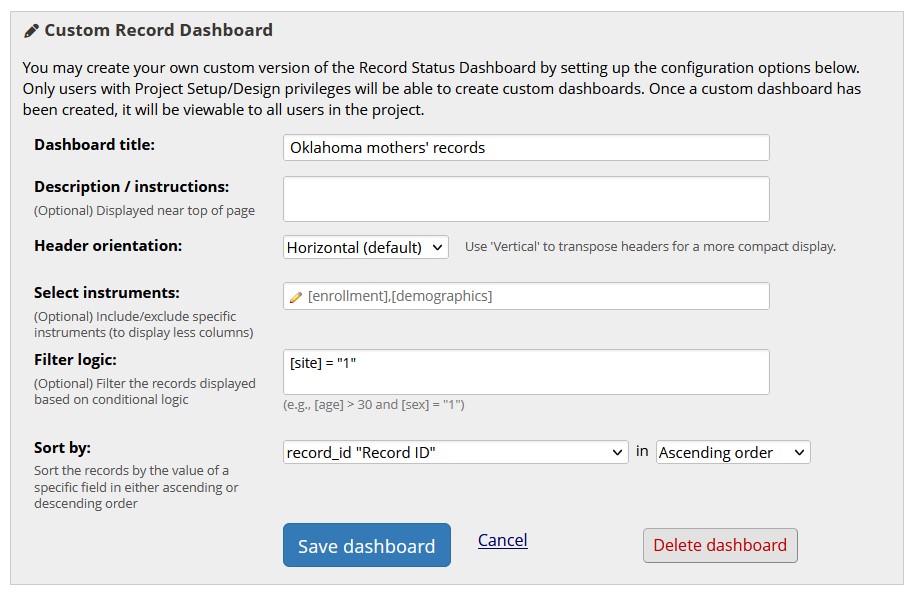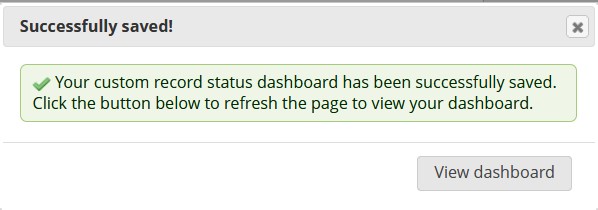5 Record Status Dashboard
Chapter Leads: Lise DeShea and Thomas Wilson
5.1 Purpose
Imagine you are in a building with several floors. You want to know about all the offices in the building. Where might you look? One place you could look is near the elevator, where you often will find a directory listing everyone with offices in the building.
That directory is similar to the Record Status Dashboard within a REDCap project. When you want to find all the records in a project, you can navigate to the Record Status Dashboard by going into the project and following the link on the left side of your screen.
When you click the link, you see a summary of all the records in the project. What is a record? It’s where all the information is kept about a specific person or entity on which data are collected. For our example project illustrated here, there are only three records and three forms:
5.2 A more complex dashboard
Let’s look at a dashboard with many more records. Will all of them show up on one page? It depends. Take a look at the screenshot below. (FYI, no private health information, PHI, will appear in these screenshots.)
It appears there are 103 records in the project, and this screen is showing the first of three pages of records. The drop-down menu at the right shows the page was set to display 50 records at a time. But the “Displaying record” field shows the records are numbered 1 through 54. That is because the creator of this project deleted a few records. The drop-down menu on the right can be set to show all records in the project.
5.3 Parsing the dashboard
What else can we learn from this page? Well, the first column of the table is labeled Project. The purpose of this REDCap project is to track the status of all research projects that involve a specific statistician at OUHC; she created the REDCap to make notes on the status of all active projects. The column label, Project, is the label on the record number. As you recall, a record is where we save all the information about a specific person or entity. Here, the entity is the name of the project. So “Record ID” was changed to “Project” to be more descriptive for the user who is tracking many research projects.
By default, nothing is shown but the number, as we see in the second screenshot on this page. With this study tracking REDCap, the first column has the number assigned to each research project, as well as the name of the research project. Displaying the name of the research project is a customization of this REDCap project. On another project, you might want the customization to show the date that a patient enrolled in a study, or some other data point that was collected.
5.4 Customizing Records
Here is how to customize what is shown next to the record ID. On the left side of the screen, look for the link called Setup.
Then look for the button that says Additional customizations.
Clicking that button opens a window, with the first customization option being Set a Custom Record Label.
In the box labeled Custom Record Label, you can see that two variable names have been listed inside square brackets, [last_name_primary_contact] and [project_name], with a comma and a space between the variable names. Any words typed that are not variable names inside square brackets also can be typed there. After you have decided on your custom label for each record, click Save and go back to the Record Status Dashboard to see how the custom label looks.
Each record on the Dashboard has a Record ID, usually a number automatically assigned by REDCap. Each number is a link to that record. The REDCap that tracks research studies has another link on the same row. Look for the column labeled Support Request. That is the only instrument in this project. As researchers request the statistician’s services, information is collected about that request. The green circles in the Support Request column are links to each project.
5.5 Navigating a record’s homepage
Clicking the record number takes you to the Record Home Page.
The legend in the top right of the following screenshot tells us the meaning of the Status circle’s color. A green circle, or button, means the record has been saved as complete. Clicking the green button takes us into the form for this research project. Let’s look at where the button’s color was determined. Look for the word Complete at the bottom of the form; that setting is responsible for the button’s color.
5.7 Repeated instances of a form
When would you have multiple copies of the same form? Let’s use this REDCap project as an example. The study involved enrolling those who were about to have a baby. Those expecting twins could participate in the study. Once the twins were born, data were collected about each twin separately – birth weight, kind of respiratory support given immediately after birth, etc.
Suppose you have entered the data on the first twin and you need to enter data about the second twin. You would find the row for that mother, go to a form you needed to complete about what happened to the second twin in the delivery room (the DR Information form), and look for the plus sign in the gray box.
Clicking that plus sign creates another copy of the same DR Information form and is a link to that copy. Data entry can proceed from there.
5.8 Customizing the dashboard
The Record Status Dashboard can be used to create custom dashboards as well. Look for the box toward the top of the page.
Clicking that box opens a form for creating the custom dashboard.
Suppose we want to create a dashboard that shows data only for the mothers who signed up in Oklahoma for this multi-site study. We will need the record number, plus the instruments called Enrollment and Demographics. We can click on the little pencil icon next to Select instruments and specify those instruments.
Then we can create filter logic that gives a statement that must be true in order to get only the records we want. In this example, we need the variable called site to equal Oklahoma. When we click in the Filter logic box, we get a Logic Editor window where the logical statement is written.
The name of the variable is in square brackets, then there is an equals sign, then the value that we want site to equal: Oklahoma. But notice: in this project, Oklahoma is the label for the site; it is not the data point that is saved in REDCap. In this project, the label Oklahoma was assigned to the number 1. The logic editor must give the data value, not the label Oklahoma. We click “Update & Close Editor,” then we click the blue button that says Save dashboard.
We get a message that the custom dashboard was saved, and we can click the gray button that says View dashboard.
Then we will see the custom dashboard that we created.
5.9 Troubleshooting
5.9.1 Can’t see all your records?
If you ever look in your REDCap project and can’t see all your records, check the settings at the top of the Record Status Dashboard and see if you have navigated to a custom dashboard that shows only some of the records. You can switch dashboards by using the drop-down menu toward the top of the page and selecting Default dashboard.
This chapter was last edited in October 2025. If you have suggested modifications or additions, please see How to Contribute on the book’s welcome page.

